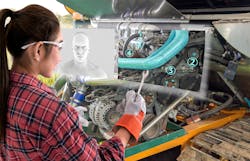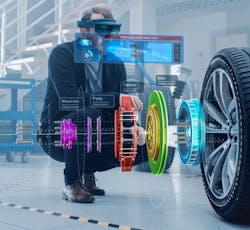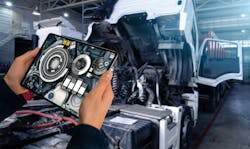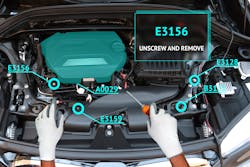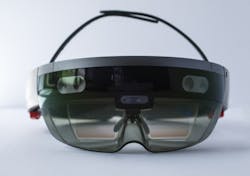How AR and VR are used to solve vehicle repair challenges
With technological advancements sweeping the world, it comes as no surprise that virtual reality (VR) has made its way into our lives. A term that was only known to tech enthusiasts a few years ago is now becoming a household concept. But what exactly is virtual reality? Let's dive into the fascinating world of VR and explore its potential in the automotive diagnostic and repair industry.
Virtual reality is a computer-generated simulation of a three-dimensional environment that can be interacted with and explored by an individual. It immerses users into a virtual world, making them feel as if they are physically present in that environment. This is achieved through the use of a head-mounted display (HMD) that encompasses the user's vision, surrounding them with virtual surroundings. By wearing the device and through the help of motion-tracking sensors, users can look around and engage with the virtual world just as they would in real life.
Although primarily used as a gaming environment, VR is not limited to gaming alone. Several industries have recognized the potential of this technology and have begun integrating it into their respective fields, including automotive diagnostics and repair.
VR vs. AR vs. MR: What’s the difference?
Virtual reality (VR), augmented reality (AR), and mixed reality (MR) are all related technologies with the common goal of altering our perception of reality. While they share some similarities, there are key differences that set them apart. Let's explore each of these technologies in more detail.
Virtual reality (VR): As mentioned in the previous paragraph, VR creates a completely immersive virtual environment that can be interacted with using specialized hardware, such as a head-mounted display (HMD) or gloves. When using VR, the user is transported to a digital world that is entirely separate from their physical surroundings. VR is often used in gaming, simulations, and training applications where users can engage with and manipulate virtual objects.
Augmented reality (AR): AR overlays virtual elements onto the real world, enhancing the user's perception of reality. It blends digital content with the real environment, allowing users to see and interact with virtual objects while still being aware of their physical surroundings. AR is typically experienced through a smartphone or tablet camera, smart glasses, or wearable technology. Popular examples of AR include “Pokémon Go,” where virtual creatures are inserted into the real world, or furniture apps that let users visualize how different pieces would look in their own homes.
Mixed reality (MR): Mixed reality combines elements of both VR and AR, allowing users to interact with virtual objects that are seamlessly integrated into the real world. MR recognizes and responds to the user's environment in real-time, enabling virtual objects to interact with real-world surfaces and objects. This technology is often used in industrial design, architecture, and prototyping. Microsoft's HoloLens is one of the most notable examples of MR devices, as it overlays interactive holographic images onto the user's physical space.
As these technologies continue to evolve, their potential applications are expanding rapidly. Interactive training simulations to assist automotive technicians, VR, AR, and MR are transforming the way we perceive and interact with our environment. For simplicity, we will use VR as a generic term for AR and MR, as well as VR for the rest of this article.
Hardware requirements
Augmented reality (AR), virtual reality (VR), and mixed reality (MR) require different types of hardware to provide users with immersive experiences. Let's explore the hardware requirements for each of these technologies:
Augmented reality (AR): AR experiences can be accessed through various devices, depending on the level of immersion and interaction desired. Some common AR hardware includes:
Smartphones and tablets: Many AR applications are available for smartphones and tablets, leveraging their built-in cameras and sensors. These devices use AR software to overlay digital content onto the real-world view captured by the camera, providing users with an augmented experience.
Smart glasses: Dedicated AR glasses, such as Microsoft HoloLens, Magic Leap, or Google Glass Enterprise Edition, offer a hands-free AR experience. These glasses typically incorporate displays, sensors, and cameras that allow seamless integration of virtual objects into the user's field of view.
Virtual reality (VR): VR requires more specialized hardware to deliver fully immersive experiences. The main components for VR hardware include:
Head-mounted display (HMD): The HMD is worn on the head and typically consists of a high-resolution display for each eye, providing a stereoscopic 3D view. Examples of popular VR HMDs include Oculus Rift, HTC Vive, and Sony PlayStation VR. These devices block out the user's physical surroundings and present them with a virtual environment.
Motion-tracking sensors: To track the user's movements and provide a sense of presence, VR systems often include sensors. These sensors can be external (e.g., mounted on walls or placed around the room) or built into the HMD. They track the user's head, body, and sometimes hand movements to provide accurate and responsive interactions within the virtual environment.
Mixed reality (MR): Mixed reality combines elements of both AR and VR, requiring specific hardware capable of blending physical and virtual worlds. Some MR devices include:
Headsets: Mixed reality headsets, like Microsoft HoloLens or Magic Leap One, are designed to overlay interactive virtual objects onto the user's real-world view. These headsets incorporate cameras, sensors, and displays to enable users to see and interact with virtual objects that are seamlessly integrated into their surroundings.
Handheld controllers: MR often involves gesture-based interactions, requiring handheld controllers or input devices. These controllers allow users to interact with and manipulate virtual objects in the mixed reality environment, enhancing the level of immersion and providing more intuitive interactions.
It's important to note that the hardware requirements for AR, VR, and MR can vary depending on the specific application or platform. Advancements in technology continue to improve the capabilities and accessibility of these devices, making them more user-friendly and affordable over time.
VR and the automotive technician
In an era where technological advancement is taking over various industries, virtual reality (VR) has emerged as a groundbreaking tool with the potential to transform the way we learn and work. While VR applications have already made headlines in gaming and entertainment, its potential impact is expanding to new realms. One such sector that stands to benefit greatly from VR is the field of auto repair, and there are signs that it can revolutionize the automotive repair profession.
Enhanced training and education: One of the key applications of VR in auto repair is in training and education. Traditionally, technicians have relied on hands-on experience and physical demonstrations for learning the intricacies of repairing vehicles. However, with VR technology, trainees can now immerse themselves in virtual environments that simulate real-life repair scenarios. This allows aspiring technicians to gain practical skills and experience without the need for expensive equipment or risking costly mistakes on actual vehicles.
Simulation-based practice: VR provides a safe and controlled environment for technicians to practice their skills before working on real vehicles. This reduces the risk of damaging customer vehicles and ensures that technicians are thoroughly trained and confident in their abilities. Whether it's disassembling an engine, diagnosing complex electrical issues, or performing routine maintenance tasks, VR simulations enable technicians to practice without any associated risks or monetary losses.
Advanced diagnostics and troubleshooting: VR can significantly improve the efficiency and accuracy of diagnostics and troubleshooting. With virtual reality, technicians can visualize complex vehicle systems in three-dimensional space, allowing them to identify potential issues more effectively. VR-based diagnostic tools can provide real-time data, allowing technicians to monitor vital signs, simulate various scenarios, and access digital repair manuals right in front of their eyes. This integration of VR with automotive diagnostics will save time, streamline repairs, and increase customer satisfaction.
Remote assistance and collaboration: With VR, technicians can now receive remote assistance from experts across the globe. By wearing VR headsets, technicians can share their live view of a vehicle, enabling remote experts to guide them through complex repairs, offer advice, and even draw annotations in the technician's field of view. This collaborative approach saves time, reduces costly travel expenses, and enhances the overall quality of repairs.
Engaging customer experience: Finally, VR has the potential to elevate the customer experience in the automotive repair industry. Some auto shops are already utilizing VR to provide interactive and informative experiences for customers. Imagine being able to virtually walk through the repair process, understanding the mechanical intricacies of your vehicle, and gaining insights into the necessary repairs. VR can bridge the gap between technicians and customers, fostering trust, understanding, and satisfaction.
How To Get Started
Acquire the necessary equipment: To get started with VR and auto technician training, it is essential to have the right equipment. You will need a VR headset capable of rendering immersive visuals and providing motion tracking. There are various options available in the market, ranging from high-end devices like the Oculus Rift or HTC Vive to more affordable options like the Oculus Quest. Additionally, you will need a compatible computer system capable of running the VR software smoothly. Make sure to check the VR headset's requirements and ensure your computer meets or exceeds them for optimal performance. Having a dedicated training space with proper lighting and minimal distractions is also advisable.
Choose a suitable VR training program: Once you have set up your VR equipment, it is time to select a suitable VR training program. There are several options available that cater specifically to auto technician training. Research different programs and choose one that aligns with your learning objectives and preferences. There are quite a few independent options available, and more OEMs are developing or have developed VR systems for use by their dealerships and licensed repair facilities.
Consider factors like the program's content, level of interactivity, and availability of real-time feedback. The ideal VR training program should provide comprehensive modules covering various automotive systems and components, along with guided instructions and assessment tools.
Start your VR training journey: With everything in place, it is time to dive into your VR training. Begin by familiarizing yourself with the interface and controls of the VR program. Take your time to explore the virtual environment and understand how different tools and car parts can be interacted with.
Follow the program's modules systematically, starting from the basics and gradually progressing to more advanced topics. Make sure to pay attention to details and practice tasks repeatedly to reinforce your learning. Additionally, don't hesitate to seek help or guidance from instructors or fellow trainees if you encounter any difficulties.
Supplement with hands-on experience: While VR training offers an excellent foundation, it is crucial to supplement it with real-world hands-on experience. Joining an apprenticeship or finding a mentor who can provide practical guidance will allow you to apply the skills you have learned in the virtual environment to real vehicles. This practical experience will solidify your knowledge and help you become a competent auto technician.
Is VR the right choice for your training program?
Virtual reality is redefining the boundaries of auto technicians, offering exciting possibilities that were once unimaginable. From immersive training experiences to advanced diagnostics and troubleshooting, VR is transforming the way technicians learn, work, and interact with customers. As technology continues to evolve, we can expect further advancements that will reshape the future of auto repairs. Embracing VR in the automotive industry will undoubtedly lead to improved efficiency, increased accuracy, and enhanced customer satisfaction.
While the potential of VR is exciting, there are still challenges to overcome. The cost of entry into the VR world can be a barrier for many, as high-end VR systems require a significant investment. Additionally, issues related to motion sickness and discomfort are still being addressed, as some individuals may experience discomfort when using VR for extended periods.
This article originally appeared on VehicleServicePros.com.
About the Author
Micheal Smyth
Micheal Smyth is a founding partner and Director of Training for AFV Educate, a not-for-profit 401(c)(3) training organization specializing in alternative fuel curriculum development and educational presentation for first and second responders and automotive technicians. His previous positions included Director of West Virginia University’s National Alternative Fuels Training Consortium and Director of Training at Automotive Video Innovations. Mike has over 12 years of experience working with and presenting information on AFVs. Connect with him at LinkedIn.
